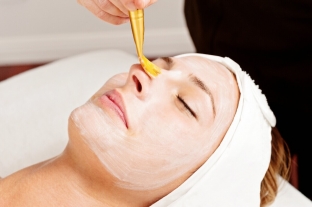Peelings have long become one of the most favorite procedures of many clients of beauty parlors. This rather simple and absolutely painless procedure is so popular with girls due to its instant effect: immediately after the procedure, the skin becomes clean, its defects are eliminated, it is smooth to the touch and seems to shine from the inside. Recently, the enzyme peeling procedure has become more and more popular, which is an excellent alternative to traditional chemical peels. Read about who enzymes are and how they are used in cosmetology on estet-portal.com today.
Use of enzyme peels to cleanse the skin
Enzymes are better known by their middle name – enzymes. These are protein molecules that control the course of biological processes and chemical reactions in the human body. In cosmetology, these enzymes are used primarily in enzyme peels for gentle exfoliation of the skin.
Enzymes – proteins are quite capricious, and their quality in cosmetics depends mainly on the pH level and temperature. Enzyme products should be stored in a dark and cool place, but when in contact with the skin, they prefer moisture and warmth.
Enzymatic peels:
- principle of operation and effectiveness of enzyme peels;
- benefits of enzyme peels over other methods;
- what skin types are suitable for enzyme peels.
The principle of operation and effectiveness of enzyme peels
Enzyme peels work according to the following principle: they dissolve the keratin scales of the stratum corneum of the skin and break down the protein bridges between them, as a result of which the dead scales are gently exfoliated. Usually, enzyme peels also contain milk and vegetable proteins, white clay, as well as vitamins and minerals. Enzymatic peels produce the following effects on the skin:
- deeply cleanse pores;
- even out skin texture;
- stimulate the production of elastin and collagen by fibroblasts, as well as cell renewal processes;
- saturate the skin with oxygen;
- eliminate fine wrinkles, age spots, fresh stretch marks and scars;
- improve skin tone and improve its color;
- prevent acne and clogged pores.

The advantages of enzyme peels over other methods
The main feature of enzyme peels is their gentle effect on the skin: they work on its surface without penetrating into the deeper layers and without mechanically irritating the skin. This type of peeling does not require recovery after the procedure, as it does not cause redness and peeling. Due to the fact that enzymes are related to the human body, the risk of allergic reactions during enzyme peeling is minimal. Enzymatic peeling does not cause photosensitivity, unlike many types of chemical peels, it can be used at any time of the year and does not require the use of SPF cream.
For which skin types are enzyme peels suitable
Enzymatic peels are a universal way to cleanse the skin – they are suitable even for sensitive and hypersensitive skin. However, the best effect of enzyme peels can be seen when cleansing:
- young skin: Enzymes are great for clearing young skin that doesn't need to address serious problems such as hyperpigmentation or acne;
- Aging and oily skin: Enzymes alone cannot solve difficult skin problems, but they perfectly complement and enhance the effect of other procedures such as dermabrasion or the use of retinoids;
- sensitive and allergic skin: for these types of skin, other types of peels and scrubs may be too aggressive, while enzyme peel – perfect.
Enzyme peels can be performed as an express procedure when the patient needs immediate results without any side effects and complications.
Enzymatic peeling – it is a great way to deeply cleanse the skin and get instant results with minimal effort. Experts can safely recommend this type of peeling to patients with any type of skin.







Add a comment